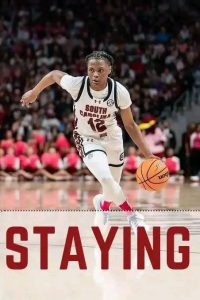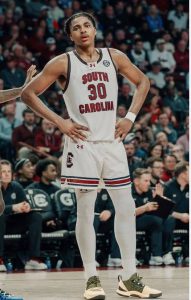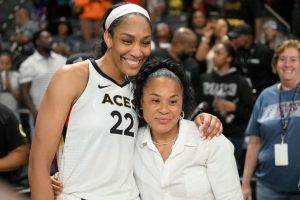BREAKING: Caitlin Clark’s struggles deepen as the Fever shake up their rotation—only to fall once again to the dominant Las Vegas Aces in a sobering defeat.

Caitlin Clark’s rookie season has been anything but ordinary, but the challenges she now faces appear to be reaching a critical point. As the Indiana Fever suffer yet another loss—this time to the reigning champion Las Vegas Aces—the questions surrounding her adjustment to the WNBA, her role within the team, and the franchise’s overall direction grow louder. What began as one of the most hyped debuts in professional basketball history has shifted into a prolonged struggle, marked by flashes of brilliance but overshadowed by inconsistency, relentless pressure, and an unforgiving learning curve.
The Fever’s latest matchup against the Las Vegas Aces served as a magnifying glass for everything that’s currently broken or unsteady in Indiana. Clark, who has already captured national headlines, record-breaking TV ratings, and a devoted fan base, found herself once again outmatched by a physical, veteran-led squad that has championship pedigree written all over it. Despite her best efforts, the rookie guard couldn’t overcome the Aces’ length, athleticism, and defensive schemes specifically tailored to contain her. Her final stat line was modest—numbers that might go unnoticed for any other rookie, but when it comes to Caitlin Clark, nothing flies under the radar.
The Fever’s coaching staff, searching for solutions, made a bold adjustment to the team’s rotation ahead of this game. Indiana brought in different personnel combinations in hopes of sparking something—anything—that could slow down the Aces and perhaps give Clark a chance to operate more freely. It didn’t work. The Fever’s chemistry remains a work in progress, their offensive flow still lacks rhythm, and defensively, they continue to struggle against elite teams. Even more telling, Clark often found herself stranded—either without the ball in her hands or overwhelmed by defenders collapsing on her as soon as she crossed half-court. The spacing issues that have plagued Indiana all season were once again on display, and it’s starting to impact her confidence and decision-making.
There is no denying that Clark is under an unprecedented spotlight. From the moment she declared for the WNBA Draft, every move, dribble, shot, and facial expression has been scrutinized. She entered the league as a cultural phenomenon, expected to elevate not just her team, but the entire WNBA. In some ways, she already has—attendance is up, television viewership has skyrocketed, and her jersey continues to sell at record pace. But within the lines of the court, Clark is still learning what it means to compete at this level. The game is faster, the defenders are stronger, and the margin for error is razor thin. She is routinely targeted by opposing defenses, with teams throwing traps, switches, and hard doubles at her to force turnovers and disrupt the Fever’s offensive flow.
The Aces, led by the likes of A’ja Wilson, Jackie Young, and Kelsey Plum, represent the gold standard in the WNBA. Their cohesion, defensive discipline, and offensive execution are near flawless when they’re clicking. They exposed every weakness the Fever currently possess, especially in how they defend pick-and-rolls and rotate on the perimeter. More importantly, they made life miserable for Clark, hounding her with physicality and refusing to let her get comfortable. The former Iowa superstar often looked like she was pressing, trying to force plays that weren’t there, which led to ill-advised passes, rushed shots, and frustrated body language.
To Clark’s credit, she continues to compete. Her work ethic is undeniable, and even in the face of adversity, she never shies away from the moment. She has taken hits—both literal and metaphorical—and continues to get back up. But basketball is a team sport, and right now, Indiana simply isn’t giving her the support she needs. The spacing is poor, the off-ball movement is stagnant, and too often, Clark is left to create something out of nothing. For a rookie adjusting to the highest level of the game, that’s an almost impossible task to execute night in and night out.
The Fever’s rotation change was a clear signal that the coaching staff is aware something must shift. There’s only so much Clark can do if the pieces around her aren’t functioning. Head coach Christie Sides is under pressure herself, trying to balance player development, team chemistry, and the weight of expectations that accompany a generational talent like Clark. She tried to stagger minutes, give Clark different running mates in the backcourt, and rotate bigs who can help set cleaner screens. Yet none of it translated into meaningful success against a superior opponent. The Aces’ defensive rotations were quicker, their transition game was smoother, and their stars delivered when it mattered most. Meanwhile, Clark and the Fever were left searching for answers.
Fans are beginning to voice their concerns too. There’s an unmistakable tension between the excitement of having Clark on the roster and the frustration of not seeing more wins. Many are questioning the team’s developmental strategy and whether the Fever are doing enough to nurture her talent. Critics point to the lack of a true floor-spacing big or a secondary ball-handler who can take pressure off Clark when defenses collapse. Others argue that she simply needs time—time to learn, to adjust, to fail and grow, as every great player does.
One of the more difficult aspects of Clark’s transition has been the physicality of the league. Unlike college basketball, where she could dominate with her vision and shot-making, the WNBA is far less forgiving. Defenders are faster, stronger, and far more experienced. She’s already taken several hard fouls that have sparked debates about player safety and officiating consistency. Some see these hits as an initiation, a message from veteran players determined not to let the league be handed over without a fight. Others view it as a failure of the league to protect one of its most marketable stars. Either way, Clark’s durability and toughness are being tested in a way they never were before.
As the Fever’s losing streak grows, so does the urgency to find stability. Clark’s development cannot be viewed in a vacuum—she needs a system that plays to her strengths, teammates who can relieve some of the pressure, and a coaching strategy that evolves with her. There’s no question she has the talent, but talent alone isn’t enough in the WNBA. It takes cohesion, structure, and confidence—three things Indiana is still trying to establish.
While losses like this one against the Aces sting, they can also serve as valuable lessons. For Clark, the path to greatness has never been about immediate dominance. Even the best players stumble early in their careers. What matters most is how they respond. She has already shown flashes—pull-up threes from the logo, dazzling no-look passes, fearless drives into traffic. Those moments remind everyone why the hype was justified. But now comes the real work: turning flashes into consistency, frustration into fuel, and potential into performance.
As for the Fever, the front office and coaching staff must be honest about where they are and where they want to go. The decision to change the rotation is a start, but more may be needed—whether it’s tweaking the offensive scheme, exploring trades, or reevaluating practice habits. The pressure will only intensify as the season progresses and the losses pile up.
Caitlin Clark didn’t come to the WNBA to be average. And the fans who fill arenas every night to see her didn’t come to watch her lose. This is a defining stretch for her and for the franchise. Every game is a lesson, every possession an opportunity to grow. But growth must be intentional, guided by leadership and supported by a team that believes in the long game. Clark has the heart, the skill, and the determination. Now it’s up to the Fever to give her the environment she needs to thrive. Until then, the struggles will continue, and so will the questions.





